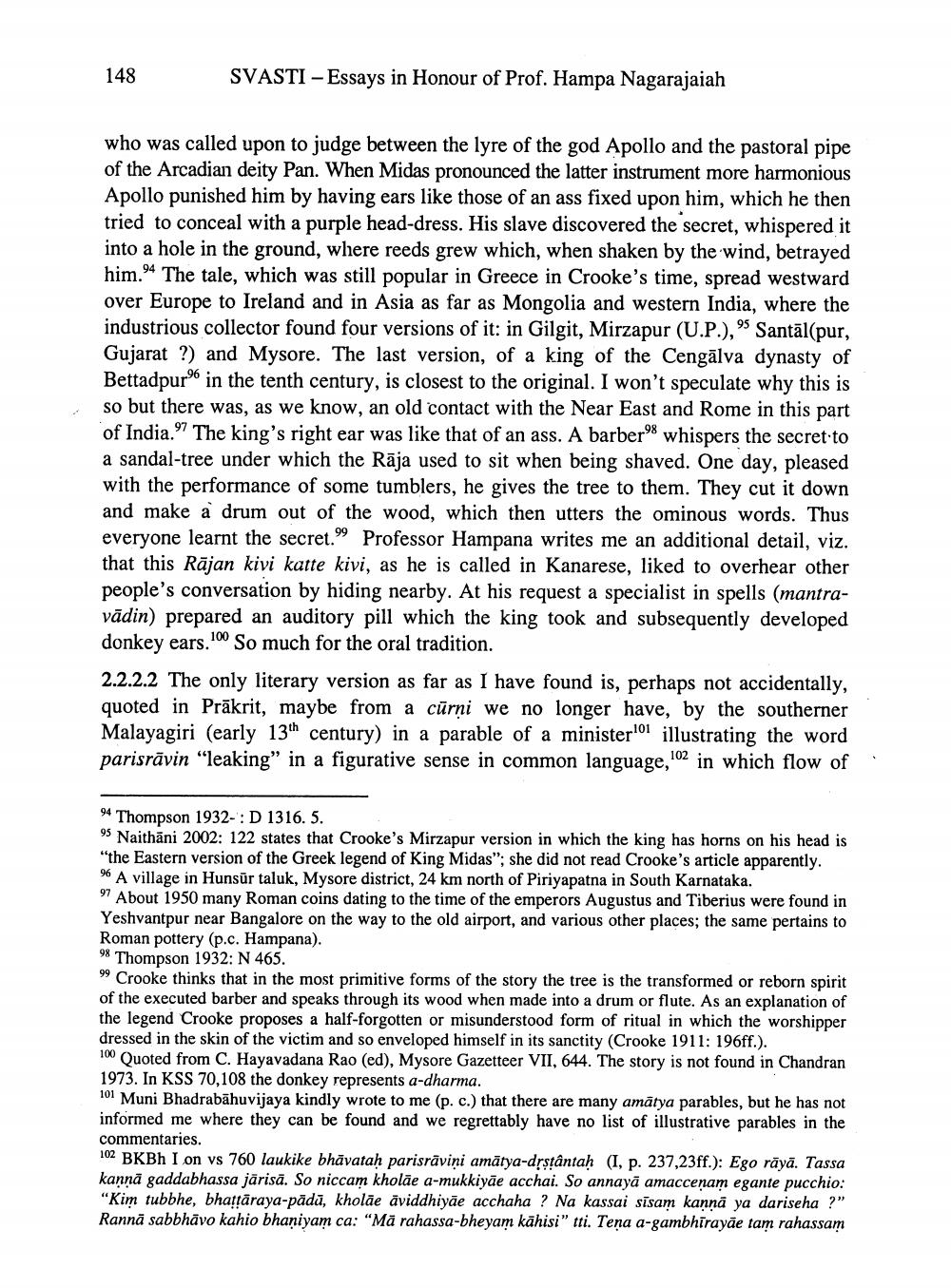________________
SVASTI Essays in Honour of Prof. Hampa Nagarajaiah
who was called upon to judge between the lyre of the god Apollo and the pastoral pipe of the Arcadian deity Pan. When Midas pronounced the latter instrument more harmonious Apollo punished him by having ears like those of an ass fixed upon him, which he then tried to conceal with a purple head-dress. His slave discovered the secret, whispered it into a hole in the ground, where reeds grew which, when shaken by the wind, betrayed him." The tale, which was still popular in Greece in Crooke's time, spread westward over Europe to Ireland and in Asia as far as Mongolia and western India, where the industrious collector found four versions of it: in Gilgit, Mirzapur (U.P.)," Santal(pur, Gujarat ?) and Mysore. The last version, of a king of the Cengalva dynasty of Bettadpur in the tenth century, is closest to the original. I won't speculate why this is so but there was, as we know, an old contact with the Near East and Rome in this part of India." The king's right ear was like that of an ass. A barber" whispers the secret to a sandal-tree under which the Rāja used to sit when being shaved. One day, pleased with the performance of some tumblers, he gives the tree to them. They cut it down and make a drum out of the wood, which then utters the ominous words. Thus everyone learnt the secret." Professor Hampana writes me an additional detail, viz. that this Rajan kivi katte kivi, as he is called in Kanarese, liked to overhear other people's conversation by hiding nearby. At his request a specialist in spells (mantravädin) prepared an auditory pill which the king took and subsequently developed donkey ears.100 So much for the oral tradition.
148
2.2.2.2 The only literary version as far as I have found is, perhaps not accidentally, quoted in Prakrit, maybe from a curni we no longer have, by the southerner Malayagiri (early 13th century) in a parable of a minister illustrating the word parisravin "leaking" in a figurative sense in common language, in which flow of
102
94 Thompson 1932-: D 1316. 5.
95 Naithani 2002: 122 states that Crooke's Mirzapur version in which the king has horns on his head is "the Eastern version of the Greek legend of King Midas"; she did not read Crooke's article apparently.
96
A village in Hunsur taluk, Mysore district, 24 km north of Piriyapatna in South Karnataka.
97 About 1950 many Roman coins dating to the time of the emperors Augustus and Tiberius were found in Yeshvantpur near Bangalore on the way to the old airport, and various other places; the same pertains to Roman pottery (p.c. Hampana).
98 Thompson 1932: N 465.
99 Crooke thinks that in the most primitive forms of the story the tree is the transformed or reborn spirit of the executed barber and speaks through its wood when made into a drum or flute. As an explanation of the legend Crooke proposes a half-forgotten or misunderstood form of ritual in which the worshipper dressed in the skin of the victim and so enveloped himself in its sanctity (Crooke 1911: 196ff.).
100 Quoted from C. Hayavadana Rao (ed), Mysore Gazetteer VII, 644. The story is not found in Chandran 1973. In KSS 70,108 the donkey represents a-dharma.
101 Muni Bhadrabahuvijaya kindly wrote to me (p. c.) that there are many amatya parables, but he has not informed me where they can be found and we regrettably have no list of illustrative parables in the
commentaries.
102 BKBh I on vs 760 laukike bhavataḥ parisrāvini amatya-dṛṣṭântaḥ (I, p. 237,23ff.): Ego rāyā. Tassa kannā gaddabhassa järisā. So niccam kholae a-mukkiyae acchai. So annaya amacceṇam egante pucchio: "Kim tubbhe, bhaṭṭāraya-pādā, kholae aviddhiyae acchaha ? Na kassai sisam kanna ya dariseha ?" Rannā sabbhāvo kahio bhaniyam ca: "Mä rahassa-bheyam kāhisi" tti. Tena a-gambhirayãe tam rahassam




